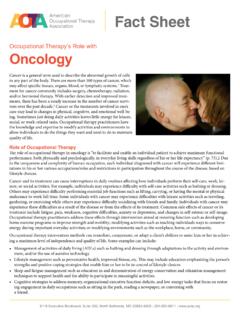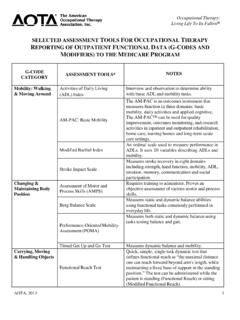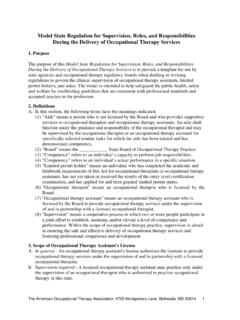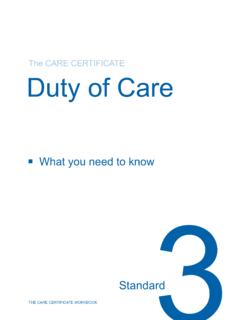Transcription of Occupational Therapy’s Role With Posttraumatic Stress …
1 Fact Sheet Occupational Therapy's Role with Post-Traumatic Stress Disorder Posttraumatic Stress disorder (PTSD) is classified as a trauma- and stressor-related disorder that develops after being exposed to or witnessing a traumatic event that is life threatening or threatens the integrity of one's self or others (American Psychiatric Association [APA], 2013). A traumatic event may include directly experiencing or witnessing emotional, physical, or sexual abuse; sexual violence; domestic or workplace violence; medical incidents or catastrophes ( , waking during surgery); severe motor vehicle accidents;. natural or human made disasters; war exposure (civilians, military personnel); incarceration as a prisoner of war; actual or threatened assault; being kidnapped or taken hostage.
2 Torture; terrorist attacks; witnessing unnatural death; or learning about serious, violent, or accidental events that affect family or close friends (APA, 2013). The symptoms of PTSD cause significant distress that impact social and Occupational participation to a degree that is clinically significant (APA, 2013). Difficulty is often evident in the person's ability to functionally engage in self- and home-care activities, education and work roles, and social and leisure interests. The ability to develop and maintain relationships is often negatively affected, and there is an increased probability of self-injurious behaviors ( , substance abuse, self-mutilation). Although the diagnostic criteria for PTSD in young children (6 years and less) is similar to that of older children, adolescents, and adults, there is often a difference in how the symptoms and behaviors manifest (APA, 2013).
3 For instance, younger children may or may not demonstrate significant distress when experiencing intrusive memories, which are often reenacted during play. Younger children with PTSD often have significant feelings of shame, guilt, fear, sadness, and confusion; therefore, they may become socially withdrawn, demonstrate problematic behaviors, and have significant difficulty with caregivers, siblings, and peer relationships. Additionally, there is often a marked decrease in activity participation, including play constriction and difficulty with school performance (APA, 2013). The Role of Occupational Therapy With Persons With PTSD. Occupational therapy practitioners are qualified mental health professionals who assist people experiencing barriers to engage in meaningful roles and occupations to increase their participation, health, and wellness (American Occupational Therapy Associa- tion [AOTA], 2010, 2014).
4 They work with individuals of all age ranges, in all phases of recovery, by helping them and their care- givers identify and address recovery-based needs and strategies within the context of real-life demands (AOTA, 2014). The term occupation refers broadly to everyday activities and roles that are meaningful and/or necessary to the individual ( , activities of daily living; work; educational activities; roles such as, parent, spouse, worker, and friend). Occupational therapists conduct a comprehensive and collaborative evaluation to identify strengths and barriers to Occupational performance and their cause(s) ( , needs, trauma triggers, environmental barriers). They provide individual and group 6116 Executive Boulevard, Suite 200, North Bethesda, MD 20852-4929 | 301-652-6611 | therapy sessions related to the impact of trauma, phases of recovery, and health/wellness strategies, often in collaboration with other professionals.
5 They also provide consultation to organizations and policy makers, and may work in supervisory, managerial, and case management positions in this area of practice. Some examples of Occupational therapy interventions include: Provide individual and/or group sessions that focus on addressing trauma triggers and warning signs; developmental issues related to early childhood trauma; symptom stabilization; and learning new coping, health, and wellness strategies ( , Stress management and relaxation techniques, sensory processing related techniques). Provide training to clients, caregivers, and interdisciplinary staff in adaptive or modified self- and home care, work, or school- based strategies, so as not to inadvertently trigger hypersensitivity patterns, dissociation, flooding, or flashbacks.
6 Help clients increase their participation in meaningful roles and activities ( , create and use a daily schedule to identify trig- gers and helpful strategies, identify and obtain the type and amount of supports necessary for successful participation, create and use a sensory diet, implement exposure techniques). Assist clients and caregivers in determining the needs and resources for home modifications for clients who also have physical barriers to participation. Promote veterans' awareness of the impact of wartime driving experiences on PTSD and assist them in addressing reactions to civilian driving situations. Where Are Occupational Therapy Services Provided? Individuals with PTSD may receive Occupational therapy services across a large variety of settings, including acute-, short-, and long-term-care facilities ( , hospitals, rehabilitation centers), partial hospitalization programs, outpatient clinics, schools, adoption and foster care agencies, day programs, supported work environments, community-based programs, home care, resi- dential programs, club houses, forensic settings, independent living and skilled nursing facilities, and military-based settings, such as Veterans Administration (VA) hospitals.
7 Conclusion Occupational therapy practitioners recognize the value of engaging in meaningful roles and daily activities to maintain and/. or regain health and well-being. Given their unique educational background in client, activity, and environmental analysis and interaction, and their rich understanding of neuroscience, anatomy, physiology, and mental health, Occupational therapy practitioners are a vital part of the interdisciplinary team working with people with PTSD and their families. References American Occupational Therapy Association. (2010). Specialized knowledge and skills in mental health promotion, prevention, and interven- tion in Occupational therapy practice. American Journal of Occupational Therapy, 64, S30 S43. American Occupational Therapy Association.
8 (2014). Occupational therapy practice framework: Domain and process (3rd ed). American Journal of Occupational Therapy, 68, S1 S48. American Psychiatric Association (2013). Diagnostic and statistical manual of mental disorders (5th ed). Washington, DC: Author. Revised by Tina Champagne OTD, OTR/L, for the American Occupational Therapy Association. Copyright 2015 by the American Occupational Therapy Association. This material may be copied and distributed for personal or educational uses without written consent. For all other uses, contact Occupational therapy enables people of all ages live life to its fullest by helping them to promote health, make lifestyle or environmental changes, and prevent or live better with injury, illness, or disability. By looking at the whole picture a client's psychological, physical, emotional, and social make-up Occupational therapy assists people to achieve their goals, function at the highest possible level, maintain or rebuild their independence, and participate in the everyday activities of life.










